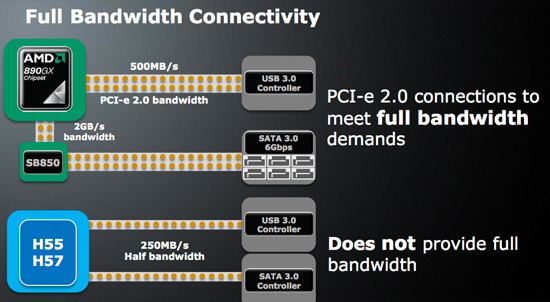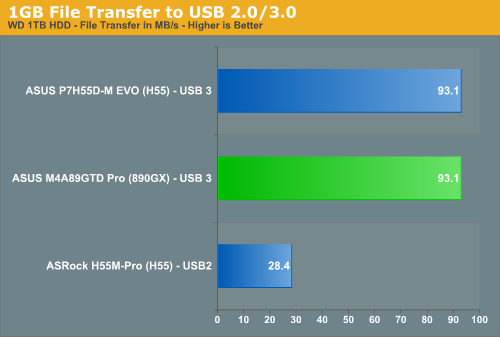AMD's 890GX Chipset - Same Graphics, Better South Bridge
by Anand Lal Shimpi on March 2, 2010 4:36 AM EST- Posted in
- CPUs
Better Suited for USB 3.0?
A little known fact is that Intel’s P55/H55/H57 chipsets run their PCIe lanes at 2.5GT/s. Meaning that a PCIe x1 lane off the chipset only offers 250MB/s in each direction. Aggregate bandwidth is 500MB/s, but that’s only attained if you’re reading at 250MB/s and writing at 250MB/s.

AMD runs all of its PCIe lanes at 5.0GT/s, so a single PCIe x1 slot offers 500MB/s up and 500MB/s down.
Neither AMD nor Intel have integrated USB 3.0 controllers, so they must rely on NEC’s PCIe-to-USB3 controller. AMD’s 890GX chipset offers roughly twice the bandwidth between the chipset and the USB 3 controller.
Today that doesn’t amount to anything. No currently available USB 3.0 peripheral can saturate PCIe 1.0 speeds, but down the road AMD’s approach will avoid any bottlenecks. I’d expect this to start being a problem towards the end of 2010 and into 2011 as we start getting more ONFI 2.0 NAND equipped SSDs that can boast 300MB/s+ read speeds.
USB Performance
No chipset launch article is complete without a never-before-seen problem and we think we hit our quota. We stumbled across an issue using Sharkoon’s USB QuickPort and our ASUS M4A89GTD Pro motherboard; hot-plugging the device into a USB 2.0 port results in a system crash whether you’re in the OS, during POST or within BIOS. The USB 3.0 ports will occasionally work with the drive and we did manage to scramble a quick test (see the graph at the bottom of the page), although the symptoms are largely the same (system hangs, loss of display).
Now, the Sharkoon QuickPort comes with its own power adapter (which it needs to work) and is fully USB 2.0/3.0 compatible, so it should not draw excessive current from the USB ports. There’s always the chance that we’ve got a faulty unit, but bear in mind that it works perfectly with nine motherboards featuring various chipsets.
One thing we noticed is that the M4A89GTD Pro seems to cut power to other USB devices briefly when plug we plug the QuickPort cable into a socket. We tried plugging the drive in while the motherboard is powered down, doing so does allow it to post and enter the OS. After that, Windows finds our USB hard drive and proceeds to load drivers. Trouble is that the drive is not displayed in the ‘My Computer’ menu, and trying to access the drive via the Disk Management snap-in does not work either; we’re continually greeted with a refresh error.
We’re leaning towards the notion of a faulty motherboard at present. ASUS have been notified and have dispatched a new board which should arrive with us shortly. In the meantime, all we’ve got to show for our efforts is 1GB file transfer time over the AMD SB850 vs. Intel’s H55/H57 to the NEC D720200F1 USB 3.0 port using a couple of 1TB Western Digital Caviar hard drives. We know it’s far from an ideal test but will have to suffice for today - sorry folks!

There’s little to divide the boards in a one 1GB file transfer using the SATA HDD’s, it’s obvious that the drives are a bottleneck. We’re aiming to put a couple of 6G SATA drives through their paces on these boards in the near future so we get a better idea of what USB 3 technology can do.










65 Comments
View All Comments
semo - Tuesday, March 2, 2010 - link
Hi Anand,I noticed something strange with my Sharkoon ( http://www.sharkoon.com/html/produkte/docking_stat...">http://www.sharkoon.com/html/produkte/d...tations/... )device recently and I thought you might find it interesting. I had a 3.5" SATA drive connected to it and I just switched off my PC. When it turned off, the case fans kept spinning (CPU fan spinning up/down constantly) and the card reader/temp sensor turned red and started beeping. It kept doing after I took off the power cord. After 10 mins of looking around and head scratching I remembered that the Sharkoon has power going to it. Unplugged that and the PC shut down. I don’t think I’ve seen this anywhere else but the Sharkoon’s USB power is actually bidirectional (the DriveLink at least). That doesn’t happen usually I think and maybe different motherboards won’t like this.
That’s unfortunate that your C300 died. I wonder why if a non essential device like drive fails, the system doesn’t POST. There shouldn’t be such a condition ever (I actually have one SATA drive that does that actually). Something as simple as removing the DVD drive belt can cause the system to POST or at least take much longer to do so. Why, the thing is not essential?
Also do you have an explanation why the Vertex LE has such good write performance compared to read. I’ve assumed that you expect the opposite from NAND flash.
Looking to full review of the 890FX, hopefully it will be more polished!
SunLord - Tuesday, March 2, 2010 - link
that has to be a defect... There is no way anyone would design something to send power into a computer via a usb port it would cause all kinda of bad voodoo for the systemSunLord - Tuesday, March 2, 2010 - link
Why does the index indicates that the 890GX is DirectX 10.1 and has UVD2 while the 790GX is DX10 and UVD1 if they are exactly the same? Is the index wrong or do these changes require no hardware tweaks?Anand Lal Shimpi - Tuesday, March 2, 2010 - link
I've updated the article a bit. The move from DX10 to 10.1 in AMD's case didn't require much of a change. Technically the 890GX is more like a 785G/790GX hybrid. Either way, performance is identical between all of the cores clocked at 700MHz.Take care,
Anand
SunLord - Wednesday, March 3, 2010 - link
Put some active cooling on it and overclock it!psychobriggsy - Tuesday, March 2, 2010 - link
At least the southbridge is better featured, with SATA3 and GigE, even if the former wasn't really tested in this review, and the latter wasn't utilised.Shame that AMD didn't bump the shader count to (e.g.,) 60, it would have made a massive difference since Intel actually put some effort in on their recent attempts. Then again, Cedar 5450 should have had 160 shaders in my opinion to make it a reasonable low-end purchase.
Clearly it's a tide-over chipset until Llano changes everything.
nice123 - Tuesday, March 2, 2010 - link
They can't boost it to 60 sadly because they are arranged in blocks of 40 - the next step up is 80, which is of course Radeon 5450 territory since they decided not to add any more shaders to that and kept it exactly the same performance as the 4550.fiki959 - Tuesday, March 2, 2010 - link
I am little disappointed with the new chipset. But there is a reason that AMD didn't improve IGP performance because doing so will probably hurt radeon 5450 sales. An improvement of 30-50% will bring the IGP very close to low end dedicated cards so maybe that is the main reason or staying with 55nm process have something to with the decision I don't know..By the way I see some Athlon 2 laptops in my country, some review for these CPUs please.
shrihara - Tuesday, March 2, 2010 - link
If it has USB 3.0 which is backward compatible, then what is the need of having USB 2.0 along with that? I was hoping that AMD 890 will come up with only USB 3.0 on board like SATA 6GBps.strikeback03 - Tuesday, March 2, 2010 - link
because for whatever reason AMD didn't include USB3 and they didn't want to spend the money/PCIe lanes on a bunch of external USB3 controllers?